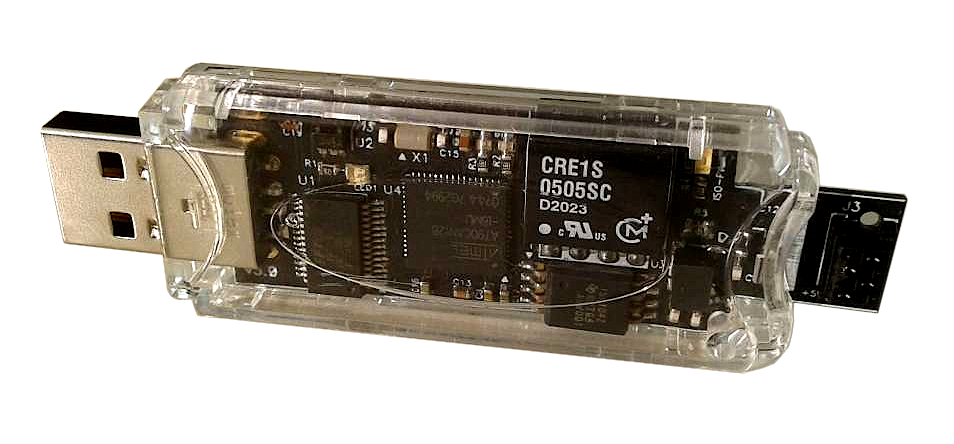USB-CAN adapter
For PC communication with:
• Passenger vehicles, trucks, buses
• Agricultural equipment
• Electronic equipment
• Industrial automation and control
• Medical instruments and equipment
• Ships and other maritime applications
• Robotics/Automation
Description of CAN Bus
CAN communication bus use for high reliable data transfer and device control in important or dangerous equipments. This standard provides a very low probability of data transmission errors, below 4,7x10-11.
The adapter was designed to manage of simple remote devices or sensors, transfer control commands or reading measured parameters. Therefore, to speed up exchange rate of data stream, is not supported the standard CANopen protocol or others complex. The main requirement was to send short messages between the computer and devices, or high-speed realtime data stream. If you need have more advanced functionality, it is possible increase by reprogram the adapter hardware to your own code. You can do this, using JTAG connector. Programming details can be found in the documentation for the device based microcontroller.
Parameters
• Full CAN 2.0A/2.0B, 11/29-bit ID
• Exchange rate: 10kbps to 1Mbps
• Exchange distance max: 10kbps to 6.7km
• Opto-Isolated CAN channels: 1
• USB connector: 2.0 type B
• CAN bus connector: AMP2178710-4
• USB driver support from FTDI
• Based on microcontroller: AT90CAN128
• Powered by a USB port on your computer
• Isolated DC/DC: +5v 80mA
• Plastic housing: 75mm x 24mm x 9mm
Application
The device uses a hardware USB FIFO chip from FTDI. This solution guarantees that the adapter will work on any operating system and always have fresh and error-free drivers. You do not need to think about support and update the driver yourself. You will be able to compile and use your applications for this multitude of operating systems. You can see the OS list on the FTDI website.Connection
Connect the adapter and the remote device with a 3-wire cable. The adapter pins: CAN-H, CAN-L and GND must match the same pins on the device. Use the demonstration programs for Windows to get started. Connect the adapter to your computer and install the USB driver. Open the folders with the demo application and run the *.exe file. The program should automatically detect the adapter and notify you. Configure the same baud rate in the adapter and device settings. The default setting is 500kbps. Press the command buttons to try to send a command or read data from the remote device.Software
The user application for working with CAN bus use API function calls from can.dll You can organize communication with a remote devices quite simply. For more details, see application examples in the attached files.Library candll
The candll library provides access to USB-CAN adapter from user application. Support automatic detection of adapters and dynamic USB-Hotplug, if the user pulls the USB device out of the port, this does not lead to the crash of the user process.
Call the function CAN_Setup_Dialog() show the dialog for manual configuration of the USB-CAN adapter parameters. Search and selection of the necessary adapter, forced setting of the exchange rate with remote devices. Remote devices can use the automatic baud rate detection procedure, if your program in the device is smart enough. But it is better to use the manual speed setting, it is much more reliable.
The call function CAN_ISP_Dialog() show the configuration and wirmware update of the remote device. In this dialog you can get and view the list of all connected remote devices. Individually rename the device or change its ID for a more comfortable and human-readable device network organization. The built-in firmware programmer (DFU) allows you to remotely update the firmware without dismantling the remote devices. Follow the prompts of the DFU-programmer for the correct firmware update.
How to integrate dll with user application
The candll can be easy attached to user application by any standard methods
Please open and look source code examples.
Example
If you buy an adapter, we will provide you with an example of a ready-made project for controlling and exchanging data with a remote device.Downloads
Files for work:
GUI Win App for ES08MD (exe)
Console Demo Win App (exe)
FTDI D2XX driver for your OS
Help:
How To flashing firmware
For developers:
GUI app source code (MSVS)
Console app source code (MSVS)
Circuits and chips:
USB-CAN circuit diagram
USB-CAN PCB board
Chip AT90CAN128
GUI Win App for ES08MD (exe)
Console Demo Win App (exe)
FTDI D2XX driver for your OS
Help:
How To flashing firmware
For developers:
GUI app source code (MSVS)
Console app source code (MSVS)
Circuits and chips:
USB-CAN circuit diagram
USB-CAN PCB board
Chip AT90CAN128
 en
en





